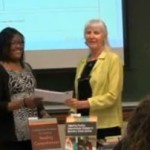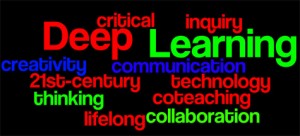By reviewing the readings and joining the Ning, I felt pretty prepared to attend the AASL Fall Forum 2012 on Transliteracy, in Greenville, South Carolina. While I was excited about aspects of participatory culture, I had real concerns about the print centric emphasis of the Common Core Standards, so I was especially interested in learning about how other educators were integrating cross media platforms as vehicles for learning.
The presenters, Henry Jenkins, Kristin Fontichiaro, and Barbara Jansen provided a whirlwind tour of the intersection of informal and formal learning through the possibilities and challenges of school environments. Throughout the intensive sessions, various models of collaboration were evident.
Henry, Kristin, and Barbara modeled a constant organic collaboration, as they shared, explored, and extended each others’ work and ideas. Instead of three separate tracks, they were able to integrate and connect ideas through conversations with each other and with the participants to present a holistic view of transmedia and learning. Henry’s closing remarks were inspiring as he made connections to the democratic power of social media.
Collaboration across time and space took place in several satellite sites. Folks in Pennsylvania, Texas, and California, were connected through a live video conference feed during the sessions. Participants at those sites could ask questions that were relayed to the presenters who then responded to all. The time difference with California, meant that the site tuned in a bit later on Saturday, but they had access to the information presented through social media networking.
During the sessions, each presenter encouraged discussion by asking probing questions, and allowing time for groups at all the sites to explore and reflect on ideas. Using Google docs, Today’s Meet, and the Ning, participants collaborated and shared conversations electronically. Those links are available are available through the Ning that is open to all who are interested.
My brain was on overload for two days, as the presenters and participants demonstrated multiple paths for thinking about teaching and learning. It was great to network with folks from other states who shared their successes and frustrations that sounded a lot like my own experiences. One woman who was in an elementary school in Georgia had 750 students in her school. Fortunately, she had flex time and a clerk. Another participant from Maine supervised paraprofessionals in several schools in a district. Some who worked in private schools were unencumbered with constraints in public schools- lots to think and talk about. The Common Core was a major buzz everywhere.
One of the participants, Linda Dougherty, created a Pinterest Board of links that were tweeted during the conference. Things went so fast, I could not keep up, so it might give you a flavor of what was covered. Have a look! Jennifer Tazerouti also shared lots of links in her Auntie Librarian Blog.
My takeaways:
Henry Jenkins, and the research and work that he does at USC and the Innovative Lab, informed us of the endless possibilities of connecting youth with media in informal learning. He showed many examples of the PLAY projects that connect popular culture to learning. Given the opportunities to analyze traditional literature such as Moby Dick through a meaningful cultural lens, incarcerated youth revealed understandings and interpretations about the overarching themes in Melville’s work. They were able to relate and produce performances that were powerful and insightful, but reflected in their own gang culture. I have a greater appreciation about how twitter, youtube, and other social media can drive ideas and movements very quickly through the world. Jenkins feels that libraries are important incubators for advancing the democratization of learning. He cited the public library in Chicago for its programs for youth after school. Another project that is in the works will be of interest to school librarians. He is working with author/illustrator David Wiesner to create a transmedia production for Flotsam (2006), with interactive components, links to oceanographic studies, and other creative options for sharing the book through multiple lenses. I was thinking that would be great to connect it with an information text such as Loree Burn’s, Tracking Trash: Flotsam, Jetsam, and the Science of Ocean Motion. (2007)
Kristin Fonticihiaro, who has unlimited energy and in depth understanding of the pedagogy of learning, gave us some background on the emergence of the term transliteracy. She asked us to think about how this concept is different from what we have been doing all along. The digital networked environment has changed that way that people read and interact with information, and we need to think about effective ways to integrate this understanding into how and what we teach in the context of the text oriented environment of the Common Core Standards. Kristin presented the contrast between informal learning as described by Henry Jenkins, and what happens in schools, where there are barriers to access to the internet, as well as, curriculum guidelines and high stakes tests.
She also focused on assessment, instructional design, and expectations for effective student work in learning with technology. She shared examples of students’ work to look for evidence of learning. Take a look at the videos and see if you can tell what the students have really learned (synthesized), and also what value the format of the report adds to the learning.
Barbara Jansen, School Librarian and author from Austin, Texas, filled in at the last minute for another speaker who could not make it. She was a treasure trove of ideas and examples for designing lessons and units that incorporated authentic challenges for students. Here is a link to the wiki that she set up for her speech, and also her virtual library. Look at the integrated assignments page, and the menu for pages that define and clarify research strategies-a model for all to take away.
Thank you to all involved in putting together a rewarding and informational experience. Barbara Jansen, coincidentally was the chairperson of the committee that organized this event, and special hats off to her for her excellent and seamless contributions to the conference at a moment’s notice.
As a participant, I came away with the feeling that there is still so much to learn about bridging the participatory gap for all our students. The folks at this conference seem have a handle on it, but as school librarians in practice, the only way we will make a difference is to be part of the conversation in our own district and school communities-think leading from the middle through collaboration. We have to have to share ideas that we learn from others who are traveling the same path, so let’s get going!
Nuff said!
Some resources mentioned above:
Burns, Loree. (2007). Tracking trash: flotsam, jetsam and the science of ocean motion. Boston: Houghton Mifflin.
Jenkins, Henry et al. (2006). Confronting the challenges of participatory culture: media education for the 21st Century. Chicago: MacArthur Foundation (white paper).
Wiesner, David. (2006). Flotsam. Boston: Clarion Books.
 The past weekend I had the pleasure of sharing a keynote and concurrent session with members of the Pennsylvania School Librarians Association (PSLA). Like many other educators around the country, Pennsylvania school librarians are wrestling with their place in the implementation of the Common Core State Standards (CCSS).
The past weekend I had the pleasure of sharing a keynote and concurrent session with members of the Pennsylvania School Librarians Association (PSLA). Like many other educators around the country, Pennsylvania school librarians are wrestling with their place in the implementation of the Common Core State Standards (CCSS).

